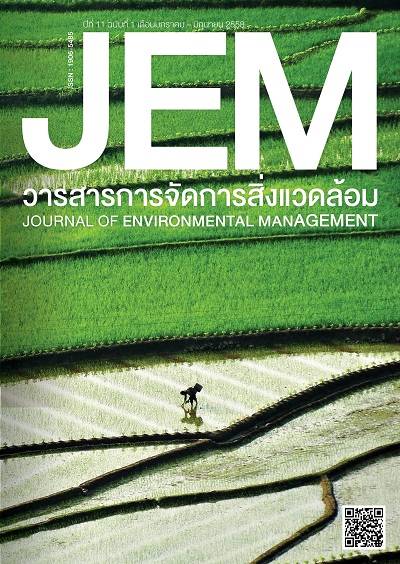คุณภาพชีวิตและข้อเสนอแนะเชิงนโยบายเพื่อการลดผลกระทบต่อคุณภาพชีวิตจากความเสื่อมสภาพของแม่น้ำลี้ จังหวัดลำพูน
DOI:
https://doi.org/10.14456/jem.2015.3บทคัดย่อ
การศึกษานี้มีวัตถุประสงค์เพื่อศึกษาคุณภาพชีวิตของประชาชนที่อาศัยอยู่ริมฝั่งแม่น้ำลี้และร่วมกันจัดทำข้อเสนอแนะเชิงนโยบาย ใช้กระบวนการวิจัยแบบผสานวิธี กลุ่มตัวอย่างประกอบด้วยประชาชนริมฝั่งแม่น้ำลี้ จำนวน 364 ครัวเรือน และตัวแทนเจ้าหน้าที่ นักวิชาการ ผู้นำชุมชนและประชาชน จำนวน 22 คน รวบรวมและวิเคราะห์ข้อมูลโดยการใช้แบบสอบถาม การสัมภาษณ์เชิงลึก การสนทนากลุ่ม และกระบวนการสัมมนาเชิงปฏิบัติการกลุ่มผู้มีส่วนได้ส่วนเสีย การวิเคราะห์ข้อมูลจากแบบสอบถามใช้สถิติเชิงพรรณนา ข้อมูลจากการสนทนากลุ่ม การสัมภาษณ์เชิงลึก และกระบวนการสัมมนาเชิงปฏิบัติการกลุ่มผู้มีส่วนได้ส่วนเสียทำการวิเคราะห์เชิงเนื้อหา พบว่า ระดับคุณภาพชีวิตของประชาชนโดยรวมอยู่ในระดับปานกลาง (ค่าเฉลี่ย 3.26 ค่าส่วนเบี่ยงเบนมาตรฐาน 0.25) ส่วนข้อเสนอแนะเชิงนโยบายพบว่า ควรสร้างเสริมกิจกรรมและสร้างแหล่งเรียนรู้ในพื้นที่ และการสร้างกฎ กติกาชุมชนบนฐานแนวคิดนิเวศวัฒนธรรม สร้างความเข้าใจและสะท้อนสภาพปัญหาคุณภาพน้ำผ่านการให้ความรู้กับกลุ่มเยาวชนในพื้นที่ และพัฒนาแนวทางการใช้ประโยชน์แม่น้ำลี้ในอนาคตโดยชุมชน รวมถึงการพัฒนาโครงการด้านการท่องเที่ยวโดยองค์กรปกครองส่วนท้องถิ่น
The objective of this study was to investigate the quality of life among the people that had settled along the Li River in Lumphun Province in Thailand and to develop public policy for reducing river degradation. The study used a mixed-methods approach, and the sample group was the people that had settled along the Li River. The sample size was 364 households in the communities and data were collected using questionnaires, in-depth interviews, and focus and stakeholder group operational seminars. Data were analyzed with descriptive statistics and content analysis. The results showed that the total quality of life was at a moderate level (mean = 3.26; S.D. = 0.25). Regarding policy recommendations, it is suggested that people participate in local activities and learning, formulate community rules on the concept of cultural ecology, understand the concept of water degradation, and explain the idea of water quality through the education of the youth. In addition, LI River utility in the future should be developed by the community, including improvement of tourism projects by the local government.
เอกสารอ้างอิง
de Graaf, I. E. M., van Beek, L. P. H., Wada, Y. & Bierkens, M. F. P. (2014). Dynamic attribution of global water demand to surface water and groundwater resources: Effects of abstractions and return flows on river discharges. Advances in Water Resources, 64, 21 - 33.
Jaitae, S. & Warodomrungsimun, C. (2013). The Li river’s Deterioration and Public Policy [In Thai]. Romphruek Journal, 31(1), 131 – 156.
Jongudomkan, D., Promphankping, B., Khlangsaeng, K. & Chanpen, U. (2014). A comparative study on the quality of life and well-being of the poor families in semi-urban area and remote area [In Thai]. Journal of nursing Science & Health, 33(3), 40 – 51.
Juergen, G. (2011). Integrative freshwater ecology and biodiversity conservation. Ecological Indicators, 11(6), 1507 – 1516.
Kijmee, V. (2008). Learning process and potential of community in Li Watershed co-management, Changwat Lamphun [In Thai]. Master’s thesis, Chiang Mai University.
Lemeshow, S., Hosmer Jr, D. W., Janelle, K & Stephen, K. L. (1990). Adequacy of Sample Size in Health Studies. Geneva: World Health Organization.
Maetuen Municipality . (2010). Reports of Generality. Retrieved July 12, 2014, from http://www.tb- maetuen.com/kamun.php
NIDA Research Center. (2012). Thais’ Quality of Life in the Year 2012 [In Thai]. Bangkok: National Institute of Development Administration.
Ping River Basin Committee. (2011). The Ping River Basin’s plan water management [In Thai]. Chiang Mai: Department of Water Resource.
Tanaree, W. & Jaitae, S. (2010). Health impact assessment on agricultural chemical utilized of farm crops Muangkaen Municipality, Maetang District, Chiangmai Province. [In Thai]. Chiang Mai: Rajabhat Chiang Mai University.
Taoprasert, Y. (2001). The way of Lanna Local Wisdom for Health Care. [In Thai]. Chiang Rai: Rajabhat Chiang Rai Institute.
Vickie, F. (2011). Floods, Drought Drive World Food Prices to Record Highs. Retrieved August 2, 2014, from http://www.accuweather.com/en/weather-news/floods-drought-drive-world-foo-1/43993
Steward, J. (1955). Theory of culture change. Chicago: University of Illinois Press.
[WHO] World Health Organization. (2014). Water resource quality. Retrieved April 6, 2014, from http://www.who.int/water_sanitation_health/resources/resquality/en/



